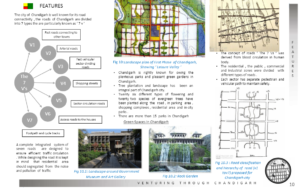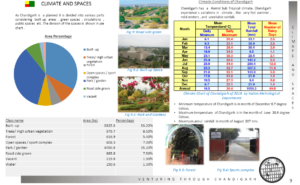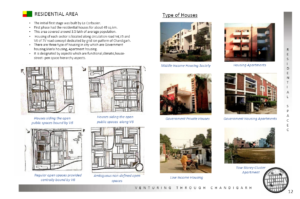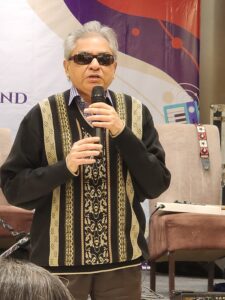“The seed of Chandigarh is well sown. It is for the citizens to see that the tree flourishes. The object of this edict is to enlighten the present and future citizens of Chandigarh about the basic concepts of planning of the city so that they become its guardians and save it from whims of individuals.:
-Le Corbusier.

Chandigarh, the capital of the states of Punjab and Haryana, and a union territory of India, is a unique city in many ways. It has the distinction of being the first planned city of post-independence India; a city planned by none other than the legendary architect and planner- Le Corbusier.
Corbusier was given the task of designing a modern Indian city by then Prime Minister Jawaharlal Nehru at the picturesque junction of the foothills of the Himalayas mountain range and the planes of the Ganges, the lifeline of India. And what a masterpiece he delivered!
He was involved in developing this modern Indian city till his demise in 1965, designing not only its master plan, but many of its institutional buildings, each one a masterpiece in itself.
Not the first choice
Very few people know that Corbusier was actually not the first choice as a planner for designing Chandigarh. American architects Albert Mayer and Matthew Navicki were first given this responsibility; they proposed a fan-shaped master plan for the city. However, Navicki passed away in 1950 and Corbusier was commissioned for the project.

A modern city with an Indian flavor
Corbusier conceived Chandigarh as a post war “Garden city”, however, here he deviated from his usual concept of a modern world-class city with clusters of tall skyscrapers and green areas at the feet of these skyscrapers. The habits of Indian people were different, so bungalows and low-rise residential buildings replaced these skyscrapers in Corbusier’s plan. This shows the master’s power of adaptability and innovation.

The planning concept- A human body
Chandigarh’s master plan was conceptualized like a human body. The city has a clearly defined Head (the capital complex- sector 1); Heart (the city center- sector 17); Lungs ( the leisure valley, countless open spaces, green areas in various sectors); Brain or Intellect (the educational and cultural institutions); Circulatory system (the network of roads, the seven vistas); and Viscera (the Industrial area).
A Grid-iron plan
Corbusier designed Chandigarh in a grid-iron pattern based on the hierarchy of movement from highways to pedestrian walkways. The master plan incorporates the master architect’s principles of light, space and greenery. The design of roads exhibits Corbusier’s vision, his farsightedness; but more about it later.
Self-sufficient sectors as units
Chandigarh has a modular plan, the unit being a sector, a neighborhood of size 800 meters by 1200 meters. These sectors are self-sufficient containing shopping areas, health centers, school, and places of recreation and worship. Each sector has some landmarks enabling even complete strangers to easily find their way. Maps are displayed all over the city for the same purpose.

Roads and parking areas
The seven vistas of Chandigarh are famous for their ingenious planning. In fact, Corbusier’s brilliance is displayed all across the city; the roads are designed and oriented in such a manner that they are under shadow during most of the day. The provision of parking spaces also exhibits master architect’s vision and the ability to plan for future. The commercial zones are provided with huge parking areas so parking is not a problem even today. Moreover, parking lanes are as broad as the main roads, making traffic here very smooth.
Pedestrian walkways are provided everywhere that are segregated from main roads with the help of lawn strips to make it convenient and safe for people. There are huge gardens along the main roads giving the city a green look and feel.

Various green areas
Chandigarh is truly a green city with different of green spaces planned for different zones. One can observe a hierarchy of green spaces throughout this wonderful city from public greens at city level to semi-private to private green spaces. You can classify them as:
Public greens with artificial water bodies
Free-flowing green areas connecting different zones
Semi-private green spaces for sector pockets
Private green spaces for residential units
Various residence types
Corbusier believed in the principle of symmetry, it helped him create harmony. He has used the same principle in Chandigarh too.
Clusters of bungalows are designed that share a common playground for kids. These bungalows also have their private lawns.
Apartments for middle class are designed in such a way that two apartments can share a common garden or playground.
Residences are designed in a symmetrical manner, so residences in a cluster look similar externally. However, Corbusier left a provision for individuals to design the interiors according to their own likings and requirements.

The city of Chandigarh is unique in many ways, it’s one of the best planned cities in the world. Le Corbusier was closely involved with the project of creating the first planned city of modern India, not only planning the city but also some of its most important buildings. The Assembly and High Court buildings exhibit the remarkable creativity of the Swiss-French architect. We will take up some of these buildings in our future posts.
Sources
www.architecture-student.com › Architecture
https://landlab.files.wordpress.com/2011/04/chandigarh-qt8.pdf
https://en.wikipedia.org/wiki/Chandigarh
https://in.pinterest.com/pin/1583303618345949
https://archeyes.com/palace-of-the-assembly-in-chandigarh-by-le-corbusie
https://www.academia.edu/84151199/Chandigarh_Study_of_Planned_City
ABOUT THE AUTHOR

Sandeep Singh is an architect from IIT Roorkee.
Ten years after graduating, he lost his vision to genetic Diabetes.
He reinvented his career and turned writer.
He has authored two fiction books and writes blogs on
Architecture, Outsourcing, Safety and a variety of other
subjects for different organizations. He also chairs and runs two NGOs
